
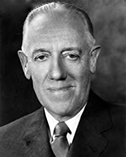 Detlev Wulf Bronk
Detlev Wulf Bronk
1950-1962 NAS President
Finally, in 1950, Richards decided that Detlev Bronk (1897-1975) was sufficiently deeply involved in a major transformation of the Academy that the latter should appropriately replace him as president. The change took place in 1950. Bronk held the post for twelve years but continued as president of The Rockefeller Institute for Medical Research in New York, which under his leadership became The Rockefeller University. Meanwhile the goals he and Jewett had envisioned for the Academy had been achieved. Many well-established conventions were overturned as the range of the Academy broadened. In effect the Academy was now administered by what amounted to a full-time president who held the key posts of governance.
When Richards gave up the presidential chair, a formal nominating committee selected by the Council of the Academy had designated James Conant as the replacement candidate with the understanding that it was to remain a part-time position. Many of the members of the Academy objected not to Conant but to a continuation of the principle that the post of president be part time with the connotation that it was substantially honorific. As a result, a group of scientists who were intimately aware of Bronk's formidable dedication to planning a new future for the Academy placed him in nomination. Once Conant understood the issues involved, he withdrew his own nomination. It might be added that when Bronk was offered the post at The Rockefeller Institute, he mused for a bit and then said: “Yes, I think I could handle that too”, implying that he perhaps intended to retain most or all of his other prestigious but burdensome administrative posts. The Rockefeller board made it clear that such a plan was not part of the deal.
As mentioned, up to this time the chairmanship of the National Research Council was not normally held by the President. Bronk soon decided after taking on his new office that the two positions should be joined to achieve optimum effectiveness in the management of the Academy. They were combined with the approval of the Council.
The Battery Additive Crisis
A special incident that eventually attracted some nation-wide attention occurred in 1953. A commercial organization began marketing an additive that it claimed would enhance the life of ordinary wet-cell lead-plate batteries. The National Bureau of Standards, headed by an excellent scientist, Dr. Allen V. Astin, carried out a routine study of the additive and determined that it was not effective as claimed. The Bureau ruled that it should be taken off the market. The head of the company was a good personal friend of a top-ranking member of the staff of the Department of Commerce, a new appointee. The latter presumably was not familiar with the ways of governmental actions and made the mistake of attempting to fire Astin. Bronk joined with Dr. Mervin J. Kelly (pictured below right), the president of the Bell Telephone Laboratories and chairman of the scientific advisory committee to the Department of Commerce, to rectify the situation, which had Washington in an uproar. Their intervention led to the reinstatement of Astin.
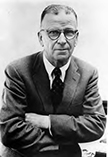 Mervin Kelly
Mervin Kelly
It should be added that Kelly (1874–1971) was a very influential figure on the scientific scene at this time, being a highly placed advisor to many prominent organizations as well as the government. He had a strong character and a lively imagination. Born in Missouri, he obtained a doctor's degree in physics under Robert Millikan at the University of Chicago. He then joined AT&T and was assigned to the laboratories of The Western Electric Company where he was in charge of improving the power and other operational properties of the vacuum tubes employed as relays in the telephone system. He was very successful in pushing that form of technology to its limits.
In the 1930s, he became fascinated with the properties of semiconductors, which were naturally conducting at ambient temperatures and had been used as rectifiers and heterodyne mixers since the turn of the century. He decided that it should be possible to develop a triode replacement for the vacuum tube with them in some way. A number of individuals had tried and failed and were continuing to do so. His opportunity to pursue this goal came in 1936 when he was appointed Director of Research of the Bell Telephone Laboratories. He gave the assignment of inventing such a triode to Dr. Walter H. Brattain one of the existing staff and Dr. William S. Shockley a new employee. The war intervened but fortunately led to the exploitation of elemental silicon and germanium as rectifiers for radar, providing excellent new candidates for experimentation after the war. Kelly reopened the quest, forming an enlarged team with the addition of John Bardeen and others with well-known success. Kelly can be regarded as the spiritual father of the transistor. His wisdom and vision was displayed by his decision to license the rights to produce the transistor to appropriate companies for the trivial price of $25,000 in order to accelerate development.
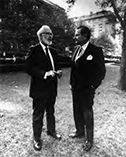 Texas Instruments
Texas Instruments
Kelly balked when he first received a request from Texas Instruments. It was a company that had been engaged in searches for likely oil-bearing strata by acoustical means before the war, but had been aided by an extraordinary young naval-volunteer engineering officer, Patrick E. Haggerty (pictured left in photo on right), in developing magnetic detectors for use in the search for submarines during the war. Haggerty had joined the company and was actively involved in a complete reorganization. Once Kelly met Haggerty, he realized that he had encountered a visionary mind comparable to his own and relented. Texas Instruments took the lead in transistor development for the next quarter of a century.
The Trial of J. Robert Oppenheimer
One of the tragic events that marked Bronk's early period in office concerned the trial of Robert Oppenheimer by the U. S. Government in 1954. The trial stemmed from concerns about his ultimate loyalty to that government. Oppenheimer had served brilliantly as the director of the Los Alamos Laboratory during World War II and justly deserved the many honors he received for his extraordinary leadership, including the position as chairman of the General Advisory Committee to the Atomic Energy Commission. When, however, President Truman proposed an exploratory program on the development of fusion weapons involving light elements as a safeguard against prior development by the Soviet Union, which had successfully produced a fission bomb in only four years, Oppenheimer, speaking for himself and his committee, expressed opposition. An investigation disclosed a not uncommon left-wing past that in his case was deemed to be sufficiently significant to revoke his access to classified material.
Harrison Brown
The activities of the foreign secretary of the Academy had traditionally been confined almost exclusively to relationships with the academies of Western Europe. When the office became vacant in 1961, Bronk appointed Professor Harrison Brown (1917–1986), a geochemist at the California Institute of Technology, to the post in 1962. The latter had wide-ranging ambitions to form bonds with science academies throughout the world, including those in communist lands, and achieved a remarkable degree of success in the process. Unfortunately, Brown became incapacitated prematurely through ill health. He did however succeed in establishing a new, greatly extended pattern for the office. Bronk had come to know Brown well as a result of his stimulating chairmanship of the Academy's Committee on Oceanography (1957–1962).
One of Brown's great ambitions was to establish relationships with the Mongolian Academy of Sciences in Ulaanbaatar when the province was under Soviet domination. Unfortunately time ran out.
The appointment of Brown, who had constructive ideas of the manner in which an expanded Office of the Foreign Secretary might better serve the promotion of international relations in science, demonstrates the way in which Bronk encouraged members of the Academy to display initiative in promoting scientific enterprises. Many other examples could be cited.
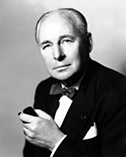 The IGY: Lloyd Berkner
The IGY: Lloyd Berkner
One other case that deserves special mention is represented by the evolution of the program involved in the International Geophysical Year (IGY) (July 1, 1957–December 31, 1958). On two previous occasions, the international scientific community had joined forces to carry out cooperative studies of the polar regions, namely in 1882–1883 and 1932–1933. One of the distinguishing events in the IGY that took place in the early 1930s was the introduction of the first microsecond pulsed radar by Dr. Hans Hollmann who used it to study the ionosphere in the polar region, but also noted that he obtained good images of the surrounding terrain on his oscilloscope.
In 1950 Dr. Lloyd Berkner (1905–1967) (pictured left),who was associated with the Carnegie Institution in Washington at the time and who was widely engaged in promoting new scientific activities and institutions both at home and abroad, proposed that the situation was ripe for the development of a worldwide program of eighteen months duration that would be devoted to geophysical research in all frontier areas. While most of the funding for U. S. participation came from the National Science Foundation, Bronk provided full encouragement and cooperation through the Academy.
Berkner, incidentally, had grown up during the period in which wireless and vacuum tube technology had matured and was a master of the field in its applications to science and engineering. His research at the Carnegie Institution had focused on gaining improved understanding of the ionosphere and its structure.
The seasonal appearance of an ozone minimum in the Antarctic was one of the many important discoveries made as a result of activities growing out of the IGY. One of the inventors of one of the techniques used, Gordon Dobson, F.R.S., proposed as a hypothesis, that it was a result of the appearance of annually periodic circumpolar cyclonic winds that prevent the influx of ozone generated in the tropics, a mainly physical phenomenon. Studies made since strongly indicate however that the destruction of ozone is primarily chemical in nature (See, for example, the review paper by Paul A. Newman, Antarctic Total Ozone In 1958, Science 164(1994): 543–46). Also major advances were made in understanding ocean-floor movement and continental drift.
Berkner furnished much of the initiative that led to the creation of the Arecibo radio telescope in Puerto Rico and the National Center for Atmospheric Research in Boulder, Colorado. Actually he displayed great persistence and imagination in pursuing important goals even as a teen-ager. One day in the early 1920s, he noted in the local Milwaukee newspaper that the Air Force was planning to offer twenty individuals in his age group an opportunity to spend that summer at one of its air bases where they would gain first-hand experience with military aviation. Applications were welcome. Lloyd said to his closest friend: “You and I are going to apply!” His friend said: “It's open to the whole country. We don't stand a chance.” Lloyd's response was: “Let's at least apply.” Their applications were not accepted, whereupon his friend said: “Just as I thought.” Lloyd responded: “Look, you and I are going down to that air base, sit in on the lectures and do everything that the other guys do, all on our own.” The two proceeded to follow this plan. One day not long after they started the proposed regime and were following the calisthenic routine of the main group in the exercise field, but out to one side, the sergeant in charge shouted: “Hey you two guys get in line!” Berkner and his friend eventually became air admirals in the Naval Reserve. His distinguished military career had in the main been devoted to applications of forefront electronics to important practical problems. His peacetime work knew almost no limits.
As his final endeavor, Berkner moved to Dallas, Texas, and with a colleague, Lauriston C. Marshall, established a technical school that reflected his personal views of the proper approach to such education. On Berkner's death, the institution was absorbed into the state university system and is now the University of Texas at Dallas. Berkner was buried in Arlington National Cemetery.
In the course of their work on the new institution, Berkner and Marshall prepared a scientific paper in which they proposed that the pattern of evolution in the post-Cambrian period was greatly influenced by a large increase in the chlorophyll-produced oxygen content of the atmosphere. This speculation appears to have survived the test of time.
James E. Webb, the future administrator of the National Aeronautics and Space Administration (NASA) in the 1960s, came to know Berkner at the height of the latter's creative period and would often ask both while leading the Agency and later: “Where are the Lloyd Berkners of today?”
Centennial Celebration
Although retired, Bronk was elected by acclimation to serve as chairman of the Centennial Celebration Committee of the Academy when it attained its hundredth birthday in 1963. The celebration was lavish and memorable for the quality of the scientific lectures5 that were presented during the event. In connection with it, the new president and the Academy Council commissioned a noted science historian, Rexmond C. Cochrane of Johns Hopkins University, to prepare a history of the Academy's first century.
By the time Bronk left office in 1962, the number of active advisory committees working within the combined framework of the Academy and National Research Council numbered in the hundreds. The organization had become both lively and productive in a sense it had not achieved since World War I. It had again become an indispensable component of the national scientific edifice.
Along with his many other activities, Bronk had an opportunity to expand the Academy's headquarters on Constitution Avenue by the addition of conforming wings on the east and west sides of the main building, thereby creating centrally located offices for some of the divisions of the National Research Council. The West Wing was funded by a generous grant from the Equitable Life Assurance Company and by special agreement carries a plaque that indicates the source of the funds. The East Wing was financed by a collection of grants from private foundations and industry. Wallace Harrison, who had helped design the original building under Goodhue, was the architect for both wings.
In departing from his post, Bronk proffered advice to his successor regarding a possible means of consolidating much of the remaining activity of the National Research Council in a single building. He had learned by chance that George Washington University had acquired much old real estate in its neighborhood and was looking for tenants who might construct and lease replacement buildings. The new president followed this suggestion, which ultimately led to what became the Joseph Henry Building at 21st and Pennsylvania Avenue. It was constructed with plans provided by the Academy and leased for twenty years from George Washington University. Other solutions for consolidation of the growing enterprise were found at a later time, including a newly constructed building at 500 Fifth Street, N.W., in downtown Washington that was opened in 2003. It was funded by the Academy, but named in honor of the Keck Foundation in recognition of a special grant, The Keck Initiative Program.
Sputnik; The Creation of NASA
In the meantime, the Soviet Union had launched a small earth-orbiting satellite, Sputnik, during the autumn of 1957. As a result, the population of the United States was overcome by something in the nature of frenzy since it appeared that Soviet rocket technology was now much ahead of that in United States. Actually our naval scientists had been given authority to develop a small satellite that was intended to be used only for scientific observations, but the program had been noted more for its failures than successes when Sputnik appeared in the sky. Fortunately, a group working under The Army Ballistic Missile Agency at Redstone Arsenal in Huntsville, Alabama, had long since prepared a back-up rocket, but had been constrained from launching it since such a step, taken by the Army, might have been regarded as “provocative” on the national as well international scene. In any case, a U. S. Army satellite launched from Cape Canaveral joined Sputnik three months later under the guidance of a group of scientists including Wernher von Braun, James A. Van Allen and William H. Pickering, much to the relief of the population.
One other consequence of the situation was the passage in Washington in 1958 of legislation needed to create a new federal agency to be called the National Aeronautics and Space Administration (NASA), along with the termination of the National Advisory Committee on Aeronautics (NACA). More will be said about this later.
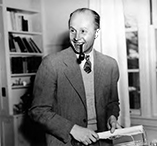 The President's Scientific Advisory Committee
The President's Scientific Advisory Committee
In part to ease public anxiety, President Eisenhower immediately appointed a high level President's Science Advisory Committee (PSAC) attached to his office that was to provide continuing advice on scientific matters both self-generated and on request. The first chairman was James Killian, the president of MIT, the second was George Kistiakowsky (pictured right) of the chemistry faculty of Harvard, the third was Professor Jerome Wiesner of MIT and the fourth was Professor Donald Hornig of Princeton University. When President Nixon took office in 1968 he appointed Dr. Lee A. DuBridge, the former president of the California Institute of Technology to the position for two years, with the condition requested by the new Secretary of Defense, former Senator Melvin Laird, that the committee cease reviewing the affairs of his department. Dr. Edward David a former member of the Bell Telephone Laboratories held it for the remaining two years of President Nixon's first term. The committee as originally conceived was eliminated early in 1973.
In response to the now rapidly developing situation in space science and technology the academy created a Space Science Board in 1958 with Lloyd Berkner as its chairman. Its purpose was manifold and in part to develop links with the members of the international scientific community interested in the field of space research.
When George Kistiakowski departed from his position as the chairman of the President's Scientific Advisory Committee in 1961, he approached Bronk with the proposal that the Academy create a counterpart committee that could work in tandem with PSAC to the extent possible and operate with more openness and freedom. Bronk, who was serving as a member of PSAC, was enthusiastic about the concept. When the plan was fully formulated and approved by the Academy's Council, it bore the name Committee on Science and Public Policy (COSPUP). Kistiakowski was its first chairman, bringing with him much of the experience he had gained at the White House.
Continue reading next chapter: Frederick Seitz

